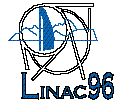Smooth Transverse and Longitudinal Focusing in High-Intensity Ion Linacs
James H. Billen, Harunori Takeda, and Lloyd M. Young
Los Alamos National Laboratory, Los Alamos, NM, USA
Abstract
We will examine several ion linac designs that start with a high-energy RFQ followed by either a drift-tube linac (DTL) or the new coupled-cavity drift-tube linac (CCDTL). For high energies a conventional CCL follows the CCDTL. High RFQ output energy allows tailoring the transverse and
longitudinal focusing strengths to match into the following structure. When the RFQ injects a higher-frequency structure, the DTL or CCDTL starts with a low accelerating gradient and large negative synchronous phase. The gradient and phase both ramp up gradually to higher values. Other changes later in the machine are also gradual. Beam-dynamics simulations show that these linacs require no separate matching sections. Applications include a cw120-mA deuteron beam produced by a 175-MHz, 8-MeV RFQ and DTL; a cw 100-mA proton beam from a 350-MHz, 6.7-MeV RFQ injecting a 700-MHz CCDTL and CCL; and a 2.5% duty, 82 mA proton beam using a 433-MHz, 10-MeV RFQ and a 1300-MHz CCDTL. These and other examples take advantage of the considerable flexibility of the CCDTL. Designs can use a variety of different transverse focusing lattices. A constant period is possible even when the number of drift tubes per cavity changes along the linac.
Announcements |
Committees |
Exhibition |
General |
Hotels |
Index |
Linacs |
Social |
Welcome |
sln 18 March 1996
 Conference
Conference Conference
Conference